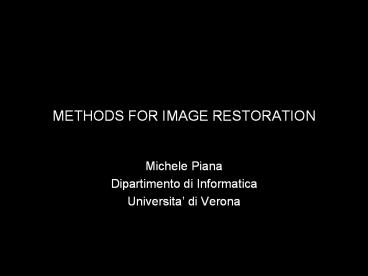METHODS FOR IMAGE RESTORATION - PowerPoint PPT Presentation
1 / 23
Title:
METHODS FOR IMAGE RESTORATION
Description:
two known quantities (data and model) two unknowns (source function and noise) one equation ... ill-posed problems are d pourvu de signification physique. Examples: ... – PowerPoint PPT presentation
Number of Views:767
Avg rating:3.0/5.0
Title: METHODS FOR IMAGE RESTORATION
1
METHODS FOR IMAGE RESTORATION
- Michele Piana
- Dipartimento di Informatica
- Universita di Verona
2
- Inverse problems and ill-posedness
3
INVERSE PROBLEMS
gh Kf h
two known quantities (data and model)
one equation
two unknowns (source function and noise)
solving IPs consists in thinking backward
thinking backward is difficult
4
ILL-POSEDNESS
Hadamard (1901)
- ill-posed problems do not have a solution, or
their solution - is not unique, or their solution does not
depend continuously - on the data
- ill-posed problems are dépourvu de signification
physique
Examples
- X-ray CT (and all kinds of tomography)
- Electro- and Magneto-encephalograpy (EEG and MEG)
- Pattern recognition
- Image deblurring
All inverse problems are ill-posed problems!!
5
A MODEL FOR IMAGE FORMATION
Given the object, the computation of the image
through the imaging equation defines the direct
problem
The inverse problem of image restoration given
the noisy image g determine the unknown object f
6
DEBLURRING
Helpful approximations
Then, through 2D Fourier transform
The inverse problem of image restoration is
often a deconvolution problem
7
NON-UNIQUENESS
If
Then
8
NON-EXISTENCE
g(?) is an irregular function (due to the noise
affecting the measurements process)
9
INSTABILITY
If
h(x) has a compact support,
Then
10
SOLUTION METHODS
Statistical approach
- inverse problems are reformulated as problems of
- statistical inference by means of Bayesian
statistics
- all quantities are modelled as random variables
- the goal is to determine the posterior
probability density - function
- many estimators error on the solution for free
11
SOLUTION METHODS
Deterministic approach
- functional spaces provide the mathematical
framework
- stability is obtained by constraining the
solutions to - belong to some particular subspace
- many algorithms historically well-established
- Tikhonov method (1963) is the first
regularization method - for linear inverse problems
- difficulty in determining the uncertainty on the
solution
- extension to non-linear problems not established
12
- Statistical approach
13
STATISTICAL GLOSSARY
- A random variable X is a function associating a
(real) - number x to the outcome of an experiment
14
STATISTICAL GLOSSARY
15
STATISTICAL GLOSSARY
- Random variable X the unknown
- Random variable Y the measurement
- Random variable E the noise
- Functional relation Yf(X,E) the physical model
16
STATISTICAL INVERSE PROBLEMS
Probability densities
17
BAYESIAN APPROACH
18
BAYES THEOREM
Then
Remark 1 only conditional probabilities, no
joint probability
19
BAYES THEOREM
Thanks to Bayes formula, an inverse problem can
be solved by three steps
- based on all prior knowledges on the unknown,
- find a prior density which judiciously reflects
these - apriori information on the solution
- find the likelihood function describing the
interrelation - between measurement and unknown (i.e.,
formulate - an accurate mathematical model of the problem)
- formulate effective computational techniques to
- assess the posterior density
20
PRIORS
The problem is the one to transform qualitative
information into a quantitative form to be
included in the prior density
Examples
- Subsurface electromagnetic sounding of the
earth - how to probabilistically describe
layered/non-layered - structures and cracks?
- Anatomical medical imaging how to
probabilistically - describe the location and surface structures of
a tumor?
21
PRIORS
- easily tractable
- approximations to non-Gaussian distributions
- (thanks to the central limit theorem)
22
LIKELIHOODS
The likelihood function contains
- the forward model
- information on the noise
(Easy) example
23
ESTIMATORS
Given the posterior density, the solution of the
inverse problems may be estimated in different
statistically-based fashions
Examples































